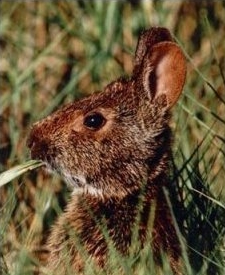Wildlife - Species

Marsh Rabbit (Sylvilagus palustris)
Description
One of the coastal area's common residents, the marsh rabbit belongs to the family Leporidae. It is one of four species of rabbits in the genus Sylvilagus that are native to the Carolinas, Virginia, and Maryland. The marsh rabbit has dark chestnut-colored fur, a bluish-gray tail, and conspicuous claws on its hind feet. It differs in appearance from the cottontail rabbit in that it does not have a white tail and its ears are shorter, measuring approximately 7.6 cm (3 in). Marsh rabbits are approximately 40 cm (16 in) long and weigh 1-2 kilograms (2-5 lbs). Like other rabbits, the marsh rabbit has two pairs of upper incisor teeth. The first pair has a chiseled edge, and the second is peg-like and is located directly behind the first. The function of this second pair of teeth is not clear.
Preferred Habitat and Biology
Marsh rabbits range from the coastal plains of North Carolina south to Alabama. They are abundant in marsh and bottomlands, in both brackish tidal marshes and wooded flood plains common to the South Carolina Lowcountry.
Marsh rabbits are polygamous. They begin reproducing before one year of age and continue breeding year round. Females typically produce an average of four young per litter, after a gestation period of 30-37 days, and can have four to six litters per year. Marsh rabbits are nocturnal and feed on a variety of plants including catbrier, centella, marsh pennywort, rushes, cane, and woody stems. They are themselves food for many carnivores in the maritime ecosystem including raptors, alligators, snakes, bobcats, wolves, and foxes. As a method of escape, marsh rabbits take to the water and are known to swim quite well.
Species Significance
Marsh rabbits are hunted for sport and food. In South Carolina, hunting season extends from November 27 to March 2, and there is a bag limit of five rabbits per day. Different counties and Wildlife Management Areas have different hunting times and regulations. Marsh rabbits are not threatened or endangered. Even though they are taken in such large numbers by top level carnivores, their high fecundity allows them to maintain stable populations.
